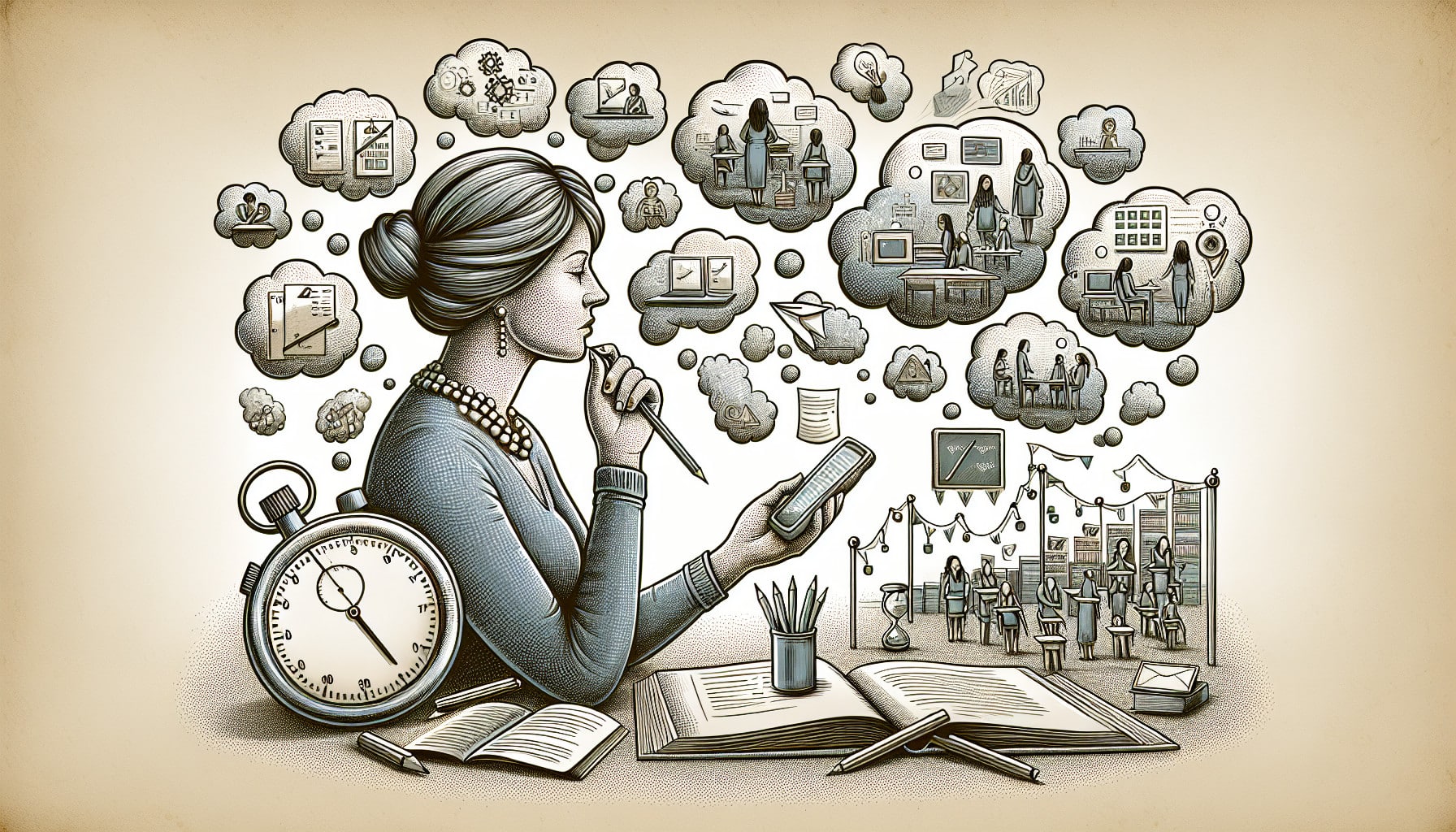Looking to navigate the roadmap of a teaching career but unsure about the turns to take and stops to make? This article cuts through the confusion to offer practical steps toward planning your teaching career. We’ll walk you through the essentials of crafting a career path, honing your skills, and moving up the educational ladder – all tailored to where you stand today and where you aim to be tomorrow.
Key Takeaways
Define clear professional objectives aligned with a teaching philosophy to guide career progression and enhance student learning outcomes.
Continuously seek professional development through training and mentorship to stay current with educational advancements and improve teaching skills.
Balance career ambitions with personal well-being by employing effective classroom management, pursuing leadership roles thoughtfully, and practicing stress management strategies.
Charting Your Teaching Journey

Embarking on a teaching career is akin to setting sail on a voyage of intellectual and emotional growth. As you navigate through this journey, it’s imperative to anchor your course with well-defined objectives and a clear vision of the impact you aspire to make in the lives of students. With keen foresight and strategic planning, you’ll chart a path that not only fulfills your professional aspirations but also enriches your teaching experience.
Envisioning Your Future in Education
Imagine standing at the helm of your career, the horizon brimming with possibilities. Identifying personal and professional objectives is your compass in this vast ocean of opportunities. When you align these objectives with a robust teaching philosophy, you create a consistent approach that not only enhances student learning outcomes but also steers your career in a rewarding direction.
Envision the bigger picture, where your passion for teaching melds with the goals you’ve set, and watch as your impact on students and schools becomes a tangible reality.
Setting Milestones for Career Progression
As you set sail, it’s crucial to map out the milestones marking your voyage in the world of education. From acquiring your initial teaching qualifications to engaging in ongoing professional development, each milestone represents a beacon guiding your professional growth.
Consider how furthering your expertise and embracing leadership roles, such as becoming a headteacher, can emerge as high-level milestones, shaping the trajectory of your teaching career.
Exploring Diverse Educational Roles
The realm of education, including secondary school, is a tapestry woven with a multitude of roles, varying from traditional classroom settings to innovative niches. Embracing roles such as e-learning tutors or special educational needs (SEN) assistants expands your teaching experience and opens doors to personal satisfaction within the sector.
Venturing into roles like learning resource managers or instructors in specialized areas can significantly enrich your educational portfolio.
Crafting a Professional Development Plan

In the dynamic world of education, where paradigms shift and new pedagogies emerge, crafting a Professional Development Plan is not just beneficial—it’s essential. Staying abreast of educational advancements and refining your teaching practices are hallmarks of an educator committed to excellence.
Good planning and a proactive approach to professional progress can catapult your teaching to new heights by acquiring new skills.
Identifying Essential Skills and Knowledge
To reach the zenith of your teaching career, you must first identify the skills and knowledge that will become the stepping stones to success. Cultivating competencies such as effective communication, problem-solving, and empathy positions you to thrive across various educational levels.
For those aspiring to leadership, embracing technology, innovation, and a nuanced understanding of school dynamics is crucial.
Finding Training and Courses
The quest for professional development is an expedition filled with rich resources designed to refine and expand your teaching skills. With a plethora of training sessions, webinars, and workshops at your fingertips, you can chart a course tailored to your unique needs and career goals.
Delve into these structured learning experiences that promise to enhance your teaching and open doors to new opportunities.
Utilizing Mentorship and Networking
In the tapestry of your teaching career, mentorship and networking are threads that weave patterns of growth and opportunity. A mentor who shares your teaching philosophy can illuminate the path ahead, offering guidance that hones your skills for professional advancement.
Networking within the educational community not only fosters professional relationships but also serves as a wellspring of support, advice, and job opportunities.
The Art of Classroom Management

The art of classroom management is a symphony of skills, where each note contributes to the harmonious learning experience of students. Mastering this art involves creating a positive atmosphere, devising engaging lesson plans, and addressing behavioral challenges with finesse.
Let’s explore how these strategies can transform your classroom into a vibrant hub of learning and growth.
Building a Positive Classroom Culture
A positive classroom culture is the bedrock upon which students build confidence and a love for learning. Establishing an environment of psychological safety ensures that students can engage freely, devoid of fear and full of curiosity.
Through team-building activities, clear expectations, and a celebration of effort, you can cultivate a growth mindset that inspires students to embrace challenges as opportunities for learning.
Effective Lesson Planning
At the heart of every successful lesson lies good planning. Crafting lessons that resonate with student interests and connect to the world beyond the classroom walls can significantly elevate the learning experience. Some strategies to consider include:
Using open-ended questions to encourage critical thinking
Allowing students to explore various possibilities and perspectives
Incorporating real-world examples and applications
Providing opportunities for hands-on learning and experimentation
By implementing these strategies, you can create engaging and meaningful lessons that promote deeper understanding and student growth.
Addressing Behavioral Challenges
The classroom is a microcosm of life’s broader challenges, and addressing behavioral issues is a test of your pedagogical acumen. By creating a supportive yet challenging environment, you help students develop the resilience and emotional intelligence that will serve them well beyond their school years.
Advancing to Leadership Positions

As your teaching career progresses, you may feel the call to leadership, a role that extends far beyond the four walls of the classroom. Leadership in education is about shaping the future—one student, one teacher, and one school at a time. The transition from teacher to leader is an evolution that requires new competencies, a broadened vision, and a commitment to the greater educational good.
Preparing for Responsibility
Stepping into a leadership role is like navigating uncharted waters; it requires a captain’s resilience and foresight. It’s not just about teaching; it involves strategic planning, staff development, and community engagement—tasks that demand robust communication, decision-making, and a keen understanding of educational policies.
Leadership Training Opportunities
The quest for leadership excellence is supported by a myriad of training programs designed to equip educators with the tools they need to succeed. Engaging in programs like the National Professional Qualification or Teach First can provide the leadership skills essential for managing schools and nurturing future generations.
Realities of School Leadership
At the helm of a school, leaders are tasked with the monumental responsibility of creating environments that promote holistic development and academic excellence. The reality of school leadership is rooted in the potential to influence not only academic proficiency but also the cultivation of socially responsible individuals.
Evaluating and Reflecting on Teaching Practices

The journey of a teacher is one of continual self-improvement, with evaluating and reflecting on teaching practices serving as key components of this process. Self-assessment, peer review, and adapting to feedback are essential tools in the teacher’s arsenal, each playing a pivotal role in polishing your pedagogical skills and enhancing your teaching career.
Self-Assessment Techniques
Self-assessment is the mirror through which educators can view their teaching practices, revealing both strengths and opportunities for growth. Techniques like journaling, portfolio compilation, and classroom recordings provide a foundation for reflection and self-evaluation.
Peer Review and Feedback
The value of peer review lies in its ability to:
Provide a fresh perspective on your teaching methods
Collaborate with colleagues for observation and feedback
Foster an environment of reflective teaching and continuous improvement.
Adapting to Feedback
As educators, it is important to view feedback as a compass that guides the refinement of lesson plans and teaching strategies. Adapting to the insights gained from peer reviews and student responses enables you to tailor your approach to better meet the diverse learning needs of your students and review progress effectively.
Balancing Work and Personal Life
In the whirlwind of a teaching career, finding equilibrium between work and personal life is a delicate dance. It’s a balance that requires intentionality and strategic management of time and resources.
Here’s how you can master the art of work-life balance, ensuring that your passion for teaching doesn’t overshadow your personal well-being.
Prioritizing and Organizing Tasks
Good planning is the cornerstone of effective work-life balance. By setting goals, employing prioritization matrices, and staying adaptable, teachers can navigate their workload with greater ease and efficiency.
Stress Management for Teachers
Managing stress is as much a skill as it is a necessity in the teaching profession. Establishing boundaries, practicing gratitude, and implementing strategies to mitigate stress are key to maintaining well-being and job satisfaction.
Finding Time for Personal Development
Personal development is an integral part of a fulfilling teaching career. Allocating time for rest, personal interests, and self-care practices is essential for nurturing personal growth and enhancing overall well-being.
Transitioning to Alternative Education Careers
As your teaching career evolves, you may find yourself yearning to explore new horizons. Transitioning to alternative careers within or outside the education sector is not only possible but can also be a rewarding continuation of your professional journey. With the right strategies, you can leverage your teaching experience to embrace new opportunities and continue contributing to the field of education.
Career Shifts within the Education Sector
For some educators, change may mean shifting to roles within the education sector that offer new challenges and rewards. Some options include:
Tutoring
Lecturing
Educational policy advisory
Student support
The options are vast and varied.
Leveraging Experience for New Opportunities
Teaching skills are highly transferable, and educators possess the abilities to thrive in numerous professions. By harnessing skills like multitasking and public speaking, teachers can transition into roles such as museum guides, freelance writers, or life coaches, among others.
Continuing Contributions to Education
Even after moving away from classroom teaching, there are numerous ways to remain connected to the education sector. Engaging in advocacy, writing, or creating motivational content can ensure that your passion for education continues to inspire others and shape the field.
Summary
As we conclude this guide, remember that your teaching career is a canvas of endless potential. From charting your journey, developing professionally, mastering classroom management, to possibly ascending to leadership roles or exploring new career paths, each step is an opportunity to make a lasting impact. Embrace the challenge, cherish the growth, and inspire the next generation of learners.
Frequently Asked Questions
What are the first steps I should take when starting my teaching career?
Start by aligning your personal and professional goals with your teaching philosophy. Then, set achievable career milestones, such as completing your teacher education and obtaining necessary qualifications. This will provide a clear path for your teaching career.
How can I stay current with educational advancements in my teaching career?
To stay current with educational advancements in your teaching career, engage in Continuous Professional Development (CPD) through training sessions, workshops, and courses, and network with peers for mentorship and insights.
Why is classroom management important, and how can I improve it?
Classroom management is important as it creates a positive learning environment crucial for student success. To improve it, focus on building a supportive classroom culture, planning engaging lessons, and addressing behavioral challenges with patience and strategy.
What opportunities are there for career advancement in teaching beyond being a classroom teacher?
Consider pursuing leadership roles such as headteacher, curriculum coordinator, or administrative positions to advance your career in teaching. Develop skills in communication, decision-making, and seek relevant training opportunities.
Can my teaching experience be valuable in careers outside of education?
Yes, teaching experience can be valuable in careers outside of education, as skills like communication and leadership are highly transferable and in demand in various fields. Consider roles such as museum guide, freelance writer, life coach, or positions in local government and beyond.


